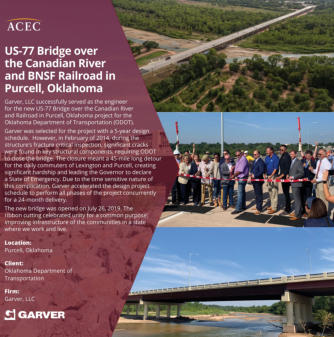
2019 Engineering Excellence Awards
2019 Grand Conceptor
Benham Design, LLC, Honored as Engineering Excellence Award "Grand Conceptor" for the I-235 Broadway Widening at 50th Street and the BNSF Railroad project.
The Oklahoma Department of Transportation (ODOT) and Benham Design partnered to widen I-235 from four lanes to six from NW 36th Street to NW 50th Street. The project included rebuilding NW 50th Street, an entrance and exit ramp, Sewell Avenue and realigning the BNSF Railway. The existing BNSF bridge was also replaced, removing a bottleneck to the widening without reducing the number of traffic lanes during construction.
This was ODOT’s largest construction package in history, at a contract bid price of $81 million. Accelerated Bridge Construction (ABC) minimized disruption to the 115,000 daily commuters and BNSF rail traffic. ABC methods also prevented the contractor from constructing the trusses over traffic or reducing the number of travel lanes during construction. The contractor erected the trusses offsite and moved them into place using Self-Propelled Modular Transports, avoiding a reduction to one lane each way on I-235 for several months. Instead, highway closure time was only needed for a single three-day weekend, and rail for less than a day. Implementing ABC greatly improved safety for workers and the public.
The project re-built the NW 50th Street entrance to I-235 SB and the exit ramp from I-235 NB to 50th Street and Santa Fe. The project extended the Deep Fork Creek drainage structure and bored a 96-inch storm sewer line underneath existing 50th Street ramps to alleviate perpetual flooding and closures of I-235 after heavy rains.
Innovative techniques allowed 30-foot tall retaining walls to be constructed adjacent to the interstate without disrupting utilities or requiring the relocation of businesses adjoining the interstate. The contract time of 850 days was reduced to 700 days using A+B bidding and careful planning. Ultimately, the project finished nearly a year ahead of schedule, allowing ODOT to proceed with the last phase of widening I-235 to six lanes through this vital corridor.
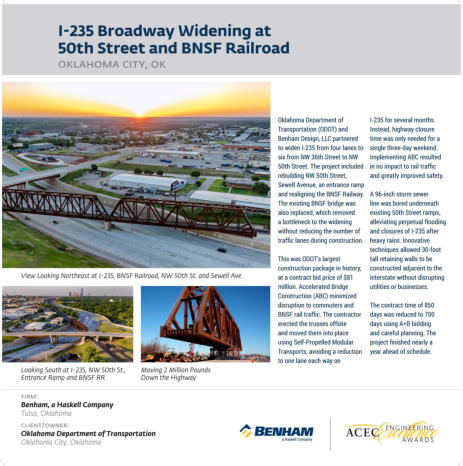
2019 Honor Award Winners
GUY Engineering Services - Bridge #15 over Mud Creek, Pawnee County
S 3460 Rd in Pawnee County is an important road to citizens in this rural community, providing a direct connection from SH-15 to an Arkansas River crossing. Bridge #15 over Mud Creek caused problems and inconvenience to those using this roadway: The unsafe and dilapidated 40ft single span pony truss, constructed in 1932, required frequent maintenance and repair and was thus often closed to traffic. When this happened, drivers, including emergency vehicles and school buses, were forced on a inconvenient detour.
GUY Engineering Services (GUY) developed an innovative steel arch bridge design that fit the unique canyon-like shape of the channel. The new bridge was the first ODOT-let steel arch bridge in Oklahoma. In addition, the 64ft-2in span x 19ft-7in rise steel plate structure was the longest steel arch span available at the time. With this arch design, GUY was able to minimize excavation costs and environmental impact in comparison to a standard PC beam bridge design.
With a new bridge in place, drivers in Pawnee County now have easier access to the Arkansas River crossing as well as improved response time for emergency vehicles . The new bridge also provides an economic benefit to Pawnee County, as it requires nearly zero maintenance . In addition, the aesthetic value of the bridge has received positive reviews, as the fascia blends in with the scenery.
ODOT used the construction of this bridge as an opportunity to provide training to their engineers on the use of such bridges. In addition, other counties and engineers are looking at the design and considering its use.
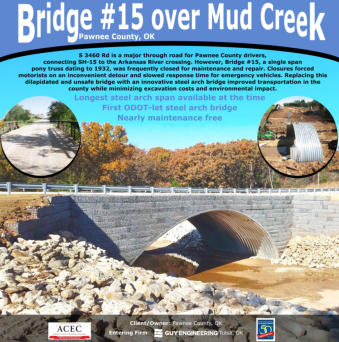
Cowan Group Engineering - City of Mustang Water Reuse Facility
Today, very few municipal wastewater dischargers in Oklahoma are reclaiming and reusing water and the City of Mustang is leading the way as an example to other municipalities for innovative reuse projects. The City’s vision and partnership with Cowan Group Engineering made it possible to provide an example to other municipalities. The Category II Water Reuse system they worked to design, construct, and implement became an apparent need to them in 2010 as they realized that they were one of the number one users of potable water to irrigate City facilities. This realization brought them to seek other sources of water rather than well field water or purchase water.
They knew that they had a reliable source of water in the water reclaimed at the wastewater treatment plant. Rather than send that water on to the nearest river, they could augment a portion of the discharge to the irrigation facilities thus saving in produced and purchased potable water. This would provide a cost savings to the City as well as the customer base which pays for infrastructure through the purchase of potable drinking water. The water reuse system was incorporated into a larger expansion project of the existing wastewater treatment plant which increased the capacity of the plant from 2.0 million gallons per day to 3.0 million gallons per day and also allowed the renaming of the plant to the Reclamation Facility. Strong partnerships and open lines of communication were created between State agencies, internal operations staff, the engineering team, contractor, management, and Parks and Recreation were instituted early to ensure that the project went smoothly from start to finish.
The project was considered a success in that it will allow the City to augment approximately 15 million gallons of potable water either produced or purchased for the irrigation of City facilities. The payback period of the reuse system is at a minimum 5 years and after that time the City can look to expand the system to provide more reuse water where applicable. The City is very proud of the project and the ability to provide insight to other municipalities as they begin the utilization of the water reuse facility.
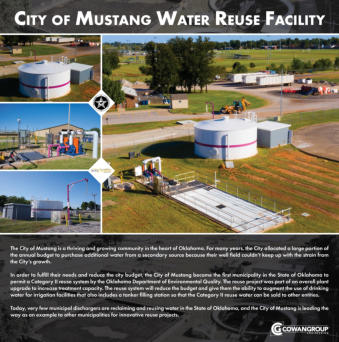
Garver - Del City Wastewater Treatment Plant Improvements
The City of Del City (the City) was in immediate need of upgrades to their wastewater treatment plant (WWTP) and processes, some of which had gone without upgrades for over 30 years. As a result, their Plant struggled to consistently meet discharge permit requirements, especially during periods with high flow. The City utilized Oklahoma’s Clean Water State Revolving Fund (CWSRF) to finance the project, and Garver worked within the City’s budget and requirements of the CWSRF to prioritize the most critical elements and provided a means to immediately address potential catastrophic failures.
Due to the aging infrastructure and equipment operating beyond its useful life, the Plant staff had a difficult time maintaining compliance with its Oklahoma Department of Environmental Quality (ODEQ) discharge permit requirements. In addition to a consent order mandating improvement to meet discharge requirements, the City was also facing a new regulation for a minimum of three basins for sequencing batch reactors (SBR) processes and the existing Plant only had two.
Garver’s initial report also identified the existing headworks was not salvageable and would need to be replaced. To complete priority headworks upgrades while maintaining service to the community, Garver completed a custom design to fit a new headworks within a tight footprint. Confirmed, careful sequencing allowed construction adjacent to the old headworks facility, keeping it operational until the new headworks could be brought online.
The project also included the integration of a non-contact UV system into an existing building, replacing a chlorine gas system and providing a safer operating environment. The non-contact system is one of the first in the state of Oklahoma, requires significantly less operation and maintenance.
During construction, systems were kept online to continue service to the community. The SBRs were rehabbed with new blowers and coarse bubble diffusers to improve their efficiency, while the contractor was required to keep at least one SBR in service at all times. Utilization of the Plant’s storm holding pond helped with receiving the influent flow, and its capacity also helped justify not constructing an additional SBR, given that the community isn’t expected to see significant growth for the foreseeable future.
Garver provided all improvements and upgrades under loan budget and helped the City effectively manage the construction to preserve around $1.2M. Garver also assisted the City with utilization of available funds to complete cost effective implementation of several upgrades by identifying items City staff could complete in-house.
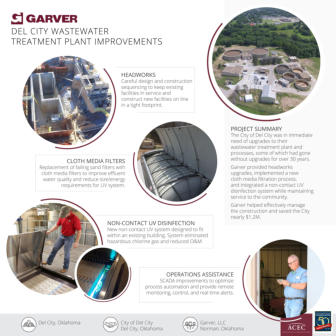
Garver - Claremore (GCM) Runway & Taxiway Rehabilitation
Claremore Regional Airport’s Runway 17-35 is the only runway at the airfield, so any construction could potentially close the airport and impact over 70 based aircraft, emergency medical services, and multiple flight schools that regularly use the airport. The project funding had originally been programmed for a traditional pavement rehabilitation consisting of milling the existing bituminous surface and constructing a bituminous overlay.
However, as design commenced, it was determined that the existing runway pavement had been constructed without a base course and was not adequate to handle the growing aircraft fleet mix using the airport. The necessary pavement design required an asphalt overlay and extensive crack repair, but this was well beyond the available budget for the project. Garver was tasked with developing an engineering solution to improve the pavement condition, preserve runway capacity, sustain access to the airport during construction, and maintain the project budget.
To overcome these challenges, Garver developed a solution that had never been implemented on an airfield in Oklahoma. The solution integrated the use of reclaiming the existing bituminous surface course to serve as a stabilized base course for a new bituminous surface course. This innovative runway rehabilitation method required collaboration with the FAA to update an outdated reclamation specification to include modern testing standards and methods, and incorporate the addition of cement and asphalt emulsion to the stabilized base to add strength while also staying flexible to mitigate the development of large block cracking in the future.
The FAA ultimately approved the bituminous pavement reclamation specification, which significantly reduced project costs and pavement closures. With the approval of this specification, the FAA now has another option for use on future airfield pavement rehabilitation projects that was not available prior to this project.
In order for the airport to remain open during construction, Garver designed the use of the parallel taxiway as an alternate landing surface during construction, and a new haul road was built so that construction vehicles could access the runway work area without crossing the alternate runway safety area.
This project also provided significant benefit to the research and educational community. Faculty and students from the University of Arkansas used this project as an opportunity to collect field data on workability, compatibility, and cohesion gain of the reclaimed asphalt material during the recycling process. This data collected proved extremely valuable, as they work with the Asphalt Emulsion Manufacturing Association to improve mix design procedures for Cold In-Place Asphalt Recycling.
These innovations resulted in a project that significantly improved the runway pavement condition, maintained access to the airport throughout construction, and was completed below the original budget.
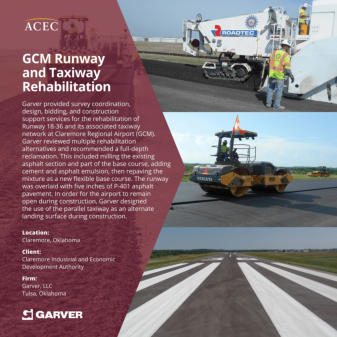
Craig & Keithline - Gilcrease Expressway North Mitigation
The Gilcrease Expressway North project is a new alignment, controlled access, divided expressway extension located in Tulsa, Oklahoma connecting US-75 Highway and the L.L. Tisdale Parkway. It is approximately 3.5 miles long. The facility is located in a partially developed mixed use (residential / commercial / light industrial) area of the City. It is located in an older, urbanized part of Tulsa and the area population is below the median income range. Funding for the project is a mixture of local, state, and federal funds accrued and expended over many years. This entry focuses on the environmental mitigation efforts developed for the facility.
Craig & Keithline, Inc. was selected to provide the design services for the project, including environmental mitigation a nd permitting. Early in the planning process the mitigation requirements were subdivided into four categories – environmental, stormwater, regulatory (404 permitting), and additional.
Environmental constraints and solutions included:
- Avoid impacts to cultural resources (Community Centers, Churches, School).
- 2 community centers, 4 churches, 1 school identified and avoided.
- 1 underpass relocated in design to accommodate projected church growth.
- Avoid impacts to automotive salvage yards.
- 2 salvage yards identified and avoided with tree screening provided.
- Remove and close old gas stations, oil wells and oil production related facilities.
- Closed & remediated 3 gas stations, 7 wells, general oilfield cleanup.
- Provide multiple city street underpasses to maintain neighborhood connectivity
- 5 underpasses provided, each with decorative sidewalks and underpass lighting. Ultimately sidewalks were provided for 9 sections of city streets.
- Provide a multi-use trail with a connection to the existing “Midland Valley Trail”.
- Included the “Gilcrease Trail Phase 1” connecting Cincinnati to the MVT.
- Stormwater constraints (solutions incorporated into regulatory constraints)
- Design a naturalized regional detention pond (Amos Hall ~ 50 Acre-Feet required).
- Remove a portion of Dirty Butter Creek from the mapped floodplain and provide appropriate compensatory storage.
- Regulatory constraints and solutions
- The primary permit constraint was the USACE 404 permit process. Craig & Keithline, Inc. developed a conceptual “full corridor” mitigation plan, portions of which were incorporated into the individual construction projects, and included:
- Define and protect natural areas (woods, wetlands and riparian habitats).
- Establish a man-made riparian habitat (meandering stream with plantings).
- Establish the regional detention pond as a man-made wetland habitat.
- The primary permit constraint was the USACE 404 permit process. Craig & Keithline, Inc. developed a conceptual “full corridor” mitigation plan, portions of which were incorporated into the individual construction projects, and included:
- Additional mitigation solutions not required but provided to address community concerns
- Compensatory storage area is wet bottom, contoured, landscaped, with trail.
- Detention pond is wet bottom, contoured, naturalized, with trail and overlook.
- Hardscaping, vinyl coated fencing, multi-use neighborhood trails, and landscaping
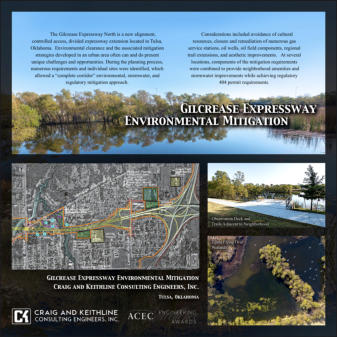
Garver - Hazardous Waste & Spill Response Training
Garver led the team responsible for providing eight, eight-hour Hazardous Waste Generator and Spill Response Training (HWGSRT) Courses to members of the Oklahoma National Guard (OKNG) on behalf of the Oklahoma Military Department (OMD). The members of the OKNG have a responsibility to stay current on their training in order to be prepared for a variety of situations that may arise and need their services. In this particular instance, the OMD and OKNG needed to update training in regards to hazardous waste and spill response. The OMD enlisted the help of the Garver Team in order to fully train nearly 80 members of the OKNG at eight different locations across Oklahoma.
Garver led a kick-off meeting with the client and team subconsultant Harbor Environmental and Safety (Harbor). After the kick-off meeting, the team began to draft the curriculum that would be taught to the OKNG members. Upon course completion, the Garver Team compiled the final curriculum and presented certificates of completion to the HWGSRT Course attendees.
When the OMD knew they needed to provide more training for their soldiers, they knew Garver was the company to do it. Close, constant communication between key stakeholders the OMD, the OKNG, Garver, and Harbor, allowed the Garver Team to provide the needed training on budget and ahead of schedule.
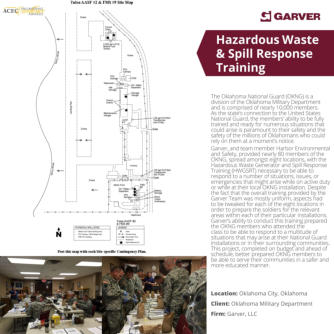
Cabbiness Engineering, CEC Corporation, Triad Design Group - MAPS 3 Trail Improvements at Lake Stanley Draper
For decades, the City of Oklahoma City (OKC) had desired to turn Lake Stanley Draper into an economic engine for southeast Oklahoma City. Small pockets of development and continued recreational opportunities have slowly improved the area, but it still lacked the one connective component to tie everything together. In 2015 the Oklahoma City MAPS Program (MAPS 3) desired to design and construct a new multi-modal trail system around Lake Stanley Draper in hopes to kick-start the desired economic engine and bring an unparalleled recreation opportunity for all of Oklahoma. In order to achieve this goal in a timely and efficient manner, the MAPS 3 planners ultimately divided the trail system into three (3) separate segments that connect and create a continuous, 13.5-mile, multi-modal trail. The three design segments were ultimately awarded to Cabbiness Engineering, LLC, CEC, and Triad Design Group (a.k.a. the Comprehensive Design Team).
The Comprehensive Design Team’s role in the Lake Stanley Draper Trail system was to analyze and design a new interconnected 12-foot wide, multi-modal trail. As part of the design contract, our Team created design alternative solutions that address the trail’s functionality, the trail’s connectivity, and the trail’s construction feasibility. Additionally, included in our project design were utility relocations, right-of-way and easement needs, construction traffic control, geotechnical concerns, trail amenities, permitting and estimated construction costs.
Some of the challenges and highlights encountered throughout this project, include:
- More elevation changes and vistas than any other trail around the Oklahoma City Metro that cleverly winds around and adjacent to Lake Stanley Draper.
- Careful trail routing to avoid extensive tree mitigation and protecting environmentally sensitive areas.
- Addressing challenging construction conditions, while also providing lake views—ultimately being one of the keys to the project’s successful completion.
- Maintaining the area’s scenic integrity, while coordinating between the three design firms—ultimately allowing our Comprehensive Team to deliver a successful, interconnected trail.
- Varying degrees of public involvement with the overall design and effectively conveying the trails vision to representatives and staff members of OKC, MAPS 3, the MAPS 3 Citizen Advisory Board, MAPS 3 Trails and Sidewalk Subcommittee, and the City Council.
- Construction inspection and administration services—throughout the construction phase, in-house construction inspectors performed regularly scheduled site inspections, documenting progress, deliverables, and coordination of any field changes necessary.
The Comprehensive Design Team was able to work together to analyze various alignments and designs. Ultimately, the team proposed unified, innovative design and construction solutions, and allowed the delivery of this $10-Million trail project within its challenging construction schedule and budget. Additionally, this project created a scenic and sustainable lifestyle initiative for the community, that connects to a network of 10 interconnected trails that can take users to almost every point in the City of Oklahoma City. This trail system will be used for generations to come and help spark economic development for southeast Oklahoma City and other surrounding communities.
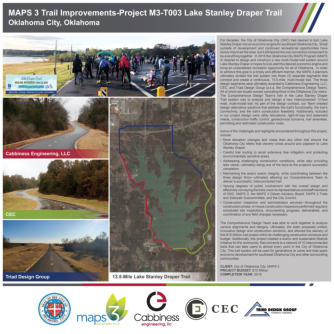
Garver - Miami, OK (MIO) Electrical Upgrades
Miami Regional Airport’s original lighting system and NAVAIDs were past their usable life and were showing significant signs of unreliability and maintenance issues. As a result, Garver worked with the FAA, Oklahoma Aeronautics Commission (OAC), and the local Owner (Sponsor) to develop a two-year project to replace all existing lighting equipment and infrastructure as well as add additional equipment to improve nighttime and low- visibility use of the airfield. The project was designed in year one and constructed in year two. This allowed the airport to provide better cash flow for the project from both their FAA entitlement funds as well as local matching funds.
The project included the following scope:
- replacement of existing stake-mounted and direct-buried incandescent runway lights with new base-mounted can and conduit LED runway lights;
- addition of LED guidance and hold signs;
- replacement of existing failing airport rotating beacon with new high intensity rotating beacon;
- replacement of unreliable 2-box incandescent Precision Approach Path Indicator (PAPI) system with more precise 4- box LED PAPI systems for both runway approaches;
- installation of new Runway End Identifier Light (REIL) system for the south runway approach;
- installation of new Omni-Directional Approach Lighting System (ODALS) for the north runway approach; • installation of new LED wind cone;
- installation of new Automated Weather Observation System (AWOS-IIIPT) complete with precipitation indication and thunderstorm detection;
- installation of new airfield electrical vault to house the power and control equipment;
- and installation of a new airport access gate complete with keypad access control.
All of these modifications and additions provided the airport with more reliable, energy-saving, and maintenance-friendly equipment. Prior to this project, the airport did not have certified weather reporting on the airfield—this addition is extremely beneficial to transient pilots as they fly long distances into the airfield.
With a project attempting to complete this extensive list of improvements, funding was the pinnacle concern. In order to ensure the project could be awarded on bid day as well as maximize the scope awarded, it was determined that a base bid of the runway lighting system and vault building coupled with additional alternatives for the other equipment was the best way to achieve this goal. This allowed the most imperative item to be awarded first and the alternatives to be awarded as the budget allowed. The contractor’s bids came in below anticipated cost, so all alternatives were awarded. The alternatives also allowed the components of the project to be divided between the FAA grant and the OAC grant.
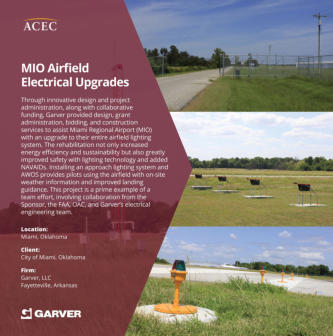
Garver - U.S. 77 Bridge over South Canadian River and BNSF Railroad
The US-77 Bridge over the Canadian River and BNSF Railroad, also known as the James C. Nance Bridge, connects Purcell and Lexington, and was originally built in 1938 as a deck truss two-lane bridge. It serves as a lifeline between the two cities which function as one community. The originally constructed bridge was listed on the National Register of Historic Places (NRHP) and was regarded as one of the most historic bridges in the state of Oklahoma. It was the third longest bridge in the state, sat fifty (50) feet high, and was the highest deck truss bridge in the state serving over 11,000 vehicles per day.
Due to the age of the structure, in 2013 ODOT solicited for a proposal to analyze the feasibility and assessment of a 3-phase design replacement of the bridge.
Garver responded to the RFP and was selected for the project with a 5-year design schedule. After selection, Garver developed plans for US-77 over the Canadian River in McClain and Cleveland Counties. The project included environmental, roadway, bridge, traffic, hydraulics, preliminary engineering and final design for the replacement of an approximately 3,750-foot-long bridge.
In February of 2014, during the structure’s fracture critical inspection, significant cracks were found in key structural components, requiring ODOT to close the bridge. The closure meant a 45-mile long detour for the daily commuters of Lexington and Purcell, creating significant hardship and leading the Governor to declare a State of Emergency. The cities received state imbursement funds for incurred expenses and a shuttle service. The detour impacted businesses, temporarily causing a loss in revenue and unforeseen expenses for the cities of Lexington and Purcell.
Garver was asked to accelerate the project schedule due to the closure. The revised schedule required performing all three phases of the project concurrently for a 24-month delivery. Garver proceeded to analyze alternatives while simultaneously designing the new bridge, a first for ODOT and Garver.
The environmental NEPA analysis was also initiated early and successfully negotiated the complexities associated with the historic structure as well as critical habitat for threatened and endangered species. Four months later, after widespread temporary and terminal repairs were made, the bridge was re-opened to traffic with heavy load restrictions. Staged construction was utilized to construct the bridge in a partial offset alignment to continuously maintain two lanes of traffic across the bridge at all times during construction. The new bridge was opened on July 26, 2019. The ribbon cutting celebrated unity for a common purpose: improving infrastructure of the communities in a state where we work and live.
